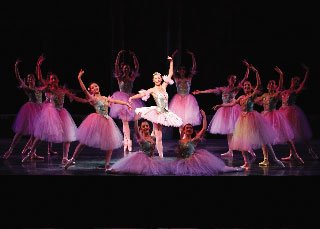”
When you’re dancing, you can forget everything,
”
Gilroyan Jennifer Watson said.
”
You connect with your body; you connect with the music for
however long that piece is. Everything else goes away and you do
that one thing that feels better than anything.
”
“When you’re dancing, you can forget everything,” Gilroyan Jennifer Watson said. “You connect with your body; you connect with the music for however long that piece is. Everything else goes away and you do that one thing that feels better than anything. It’s not just moving – my whole soul feels better when I’m doing it. I smile just thinking about it. I get emotional when I talk about it.”
Watson is a Gilroy raised and trained dancer and an assistant director for the annual performances of “The Nutcracker” at the San Jose Center for the Performing Arts, Dec. 5 through 7.
“What makes San Jose Dance Theatre’s production special is that it gives over 100 young dancers from around the area the ability to perform at a professional level,” Watson said. “San Jose Dance Theatre is the only nonprofit production that annually welcomes children ranging from six to 18 to perform at the Center of Performing Arts in downtown San Jose. This is their 43rd year.”
The San Jose “Nutcracker” is a long-standing tradition for Watson. This season marks her 20th year with the production.
“I grew up dancing in it,” Watson said. “About twenty of us kids carpooled up there every year.”
It was always a family affair as well, she said. Her father worked with the stage crew, her mother did make-up and her two younger sisters helped wherever needed, from being runners to playing urchins.
Watson trained with the Julie Reynolds School of Ballet in Gilroy for 13 years. She first began dancing when her kindergarten teacher suggested it as a way of helping her to develop better coordination.
“I fell in love with it,” Watson said. “I can’t remember life without ballet.”
She was a dancer in “The Nutcracker” for 10 seasons and worked on the stage crew, doing make-up, leading backstage tours, providing outreach programs to local schools and selling tickets in the box office. She also served on the Board of Directors for 1.5 years.
“It’s not Christmas until I’m backstage at ‘The Nutcracker,'” she said.
Watson has returned as a production assistant for the past nine years. This year is her first as an assistant artistic director. As a graduate student in education from San Jose State University, she uses her experience with San Jose Dance Theatre to teach young children about the arts.
“Whether or not they become dancers, it’s an experience that will stick with them,” Watson said. “It teaches self-confidence. It teaches discipline. It teaches a respect for the arts. They take this experience with them long after they stop performing.
“For example, to dance the Snow Scene in ‘The Nutcracker’ is an accomplishment,” she said. “You’re part of a team. You’re only as good as you can make the group look together. You have to move as one. All 16 dancers have to be in unison, or it looks sloppy. Anyone can go out and dance by themselves, but you know if you mess up in this, there are 15 other dancers relying on you to be on your game.”
The young dancers also get the experience of dancing side by side with professional dancers hired for the most demanding roles, such as the Sugar Plum Fairy and the Cavalier.
“The younger dancers in the production look up to the older ones,” Watson said “And the 16- to 18-year-olds need someone to look up to as well, so we hire professionals as role models.”
San Jose Dance Theatre also educates school children about the arts.
“We do performances for school children,” she said. “We come to students’ classrooms and read them the story of ‘The Nutcracker’ and show them what a nutcracker is and explain ballet to them. If we have a student in the school, we have them come in their costume and tell the students about their role. It’s such a reward to work with these kids.”
In a time when the arts are becoming harder for children to have access to, “we give ‘Nutcracker’ tickets to children in shelters, and we give tickets to neighborhood organizations where families wouldn’t otherwise get to do things like this, so they too can have this experience,” Watson said. “We donate 250 tickets for each show as a way to give back to the community. We survive on volunteering and people getting the word out.
“Tickets for good seats are still available, and Christmas in the Park is also on display close by,” she said. “Many families come and make a day of it.”















